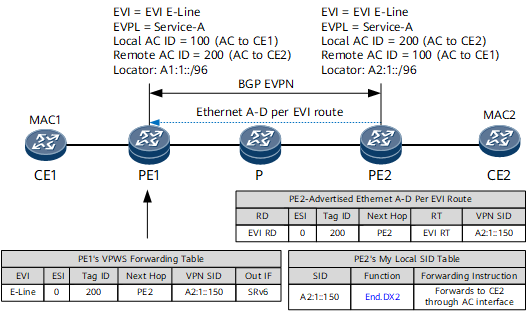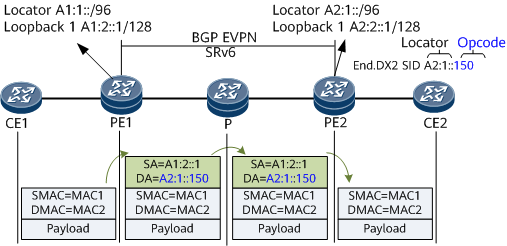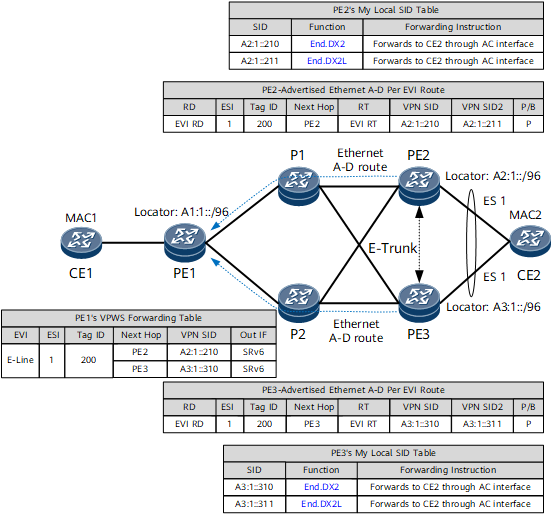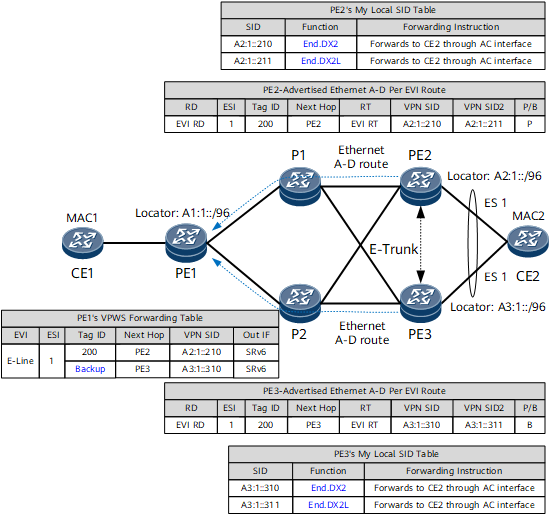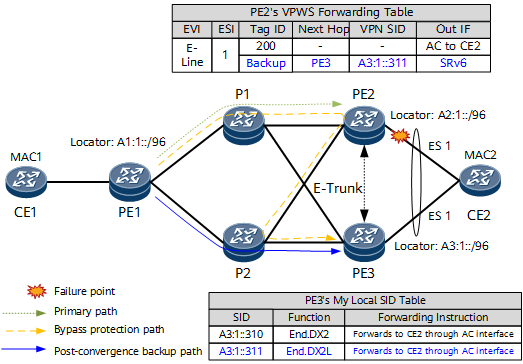EVPN VPWS over SRv6 BE
The EVPN virtual private wire service (VPWS) over SRv6 BE solution uses SRv6 BE over a backbone network to simplify EVPN VPWS — a technology that provides a P2P L2VPN service based on the EVPN service architecture. This solution allows Layer 2 packets to be forwarded along access circuit (AC) connections without the need to search for MAC forwarding entries. It can be deployed in single-homing, dual-homing single-active, and dual-homing active-active scenarios.
EVPN VPWS over SRv6 BE Single-Homing Scenario
Figure 1 shows how routes are advertised in an EVPN VPWS over SRv6 BE single-homing scenario.
The route advertisement process is as follows:
An EVPL instance and an EVPN VPWS instance are configured both on PE1 and PE2. Each EVPL instance is bound to an AC interface and an EVPN VPWS instance and configured with a local service ID and a remote service ID. After the configuration, each PE generates a forwarding entry associating the AC interface with the EVPL instance.
PE1 and PE2 exchange the Ethernet A-D per EVI route, which carries information such as the RD, route target (RT), next hop, local service ID, and SRv6 SID.
After receiving the route from the peer end, PE1 and PE2 leak the route to the desired EVPN VPWS instance based on RTs and recurse the route to an SRv6 BE path based on SRv6 SIDs. If the service ID of the received route is the same as the remote service ID configured for the local EVPL instance, PE1 and PE2 generate a forwarding entry associating the SRv6 BE routes with their local EVPL instances.
Figure 2 shows how data is forwarded in an EVPN VPWS over SRv6 BE single-homing scenario.
CE1 sends a common Layer 2 packet to PE1.
After receiving the packet from the AC interface bound to the EVPL instance, PE1 searches the VPWS forwarding table and finds the SRv6 VPN SID and the next hop associated with the configured ESI. PE1 then encapsulates the packet into an IPv6 packet using the SRv6 SID A2:1::150 as the destination address.
PE1 finds the route A2:1::/96 based on the longest match rule and forwards the packet to the P device over the shortest path.
Likewise, the P device finds the route A2:1::/96 based on the longest match rule and forwards the packet to PE2 over the shortest path.
PE2 searches My Local SID Table for an End.DX2 SID that matches A2:1::150. According to the instruction specified by the SID, PE2 removes the IPv6 packet header and forwards the original Layer 2 packet to CE2 through the AC interface bound to the EVPL instance corresponding to the End.DX2 SID.
EVPN VPWS over SRv6 BE Dual-Homing Active-Active Scenario
Figure 3 shows how routes are advertised in an EVPN VPWS over SRv6 BE dual-homing active-active scenario.
The route advertisement process is as follows:
An EVPL instance and an EVPN VPWS instance are configured both on PE1, PE2, and PE3. Each EVPL instance is bound to an AC interface and EVPN VPWS instance and configured with a local service ID and a remote service ID. After the configuration, each PE generates a forwarding entry associating the AC interface with the EVPL instance.
PE2 and PE3 both send an Ethernet A-D per EVI route to PE1 using BGP EVPN. The Ethernet A-D per EVI routes carry RDs, RTs, next hops, local service IDs, SRv6 SIDs, and all-active mode information. The SRv6 SIDs also include End.DX2L SIDs used for bypass protection.
After PE1 receives the Ethernet A-D per EVI routes from PE2 and PE3, PE1 processes the route in the same way as that in the EVPN VPWS over SRv6 BE single-homing scenario. In the dual-homing active-active scenario, PE1 selects both PE2 and PE3 to balance traffic.
The data forwarding process in the EVPN VPWS over SRv6 BE dual-homing active-active scenario is similar to that in the single-homing scenario. For details, see related description in the single-homing scenario.
EVPN VPWS over SRv6 BE Dual-Homing Single-Active Scenario
Figure 4 shows how routes are advertised in an EVPN VPWS over SRv6 BE dual-homing single-active scenario.
The route advertisement process in the EVPN VPWS over SRv6 BE dual-homing single-active scenario is similar to that in the dual-homing active-active scenario. The only difference is that the all-active mode information carried by PE2 and PE3 is different in the two scenarios. In Figure 4, the master/backup status of PE2 and PE3 is determined by E-Trunk negotiation. Through negotiation, PE2 stays in the master state and PE3 in the backup state.
After receiving the Ethernet A-D per EVI routes from PE2 and PE3, PE1 selects the route advertised by PE2 as the preferred route and preferentially forwards user traffic to PE2.
AC-Side Fault Protection in Dual-homing Scenarios
On the network shown in Figure 5, if the link between PE2 and CE2 fails, PE2 detects the fault and performs an FRR switchover. It then adds an End.DX2L SID to the data traffic, with the next hop pointing to PE3, and forwards the traffic to PE3 along the shortest path. After receiving the traffic, PE3 searches My Local SID Table for a matching End.DX2L SID. According to the instruction specified by the SID, PE3 removes the IPv6 packet header and forwards the original Layer 2 packet to CE2 through the AC interface bound to the EVPL instance corresponding to the End.DX2L SID.
PE2 then sends a BGP Withdraw message to its BGP EVPN peer PE1 to withdraw the advertised Ethernet A-D per EVI route. After receiving the message, PE1 selects the Ethernet A-D per EVI route received from PE3 as the preferred route and forwards subsequent data traffic to PE3.
